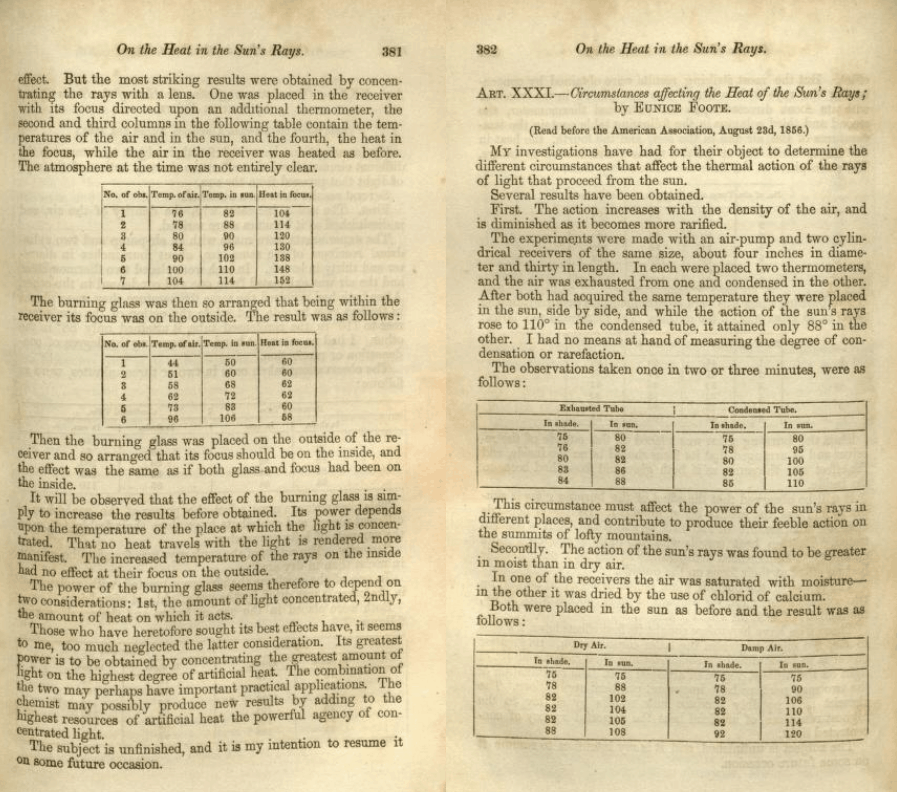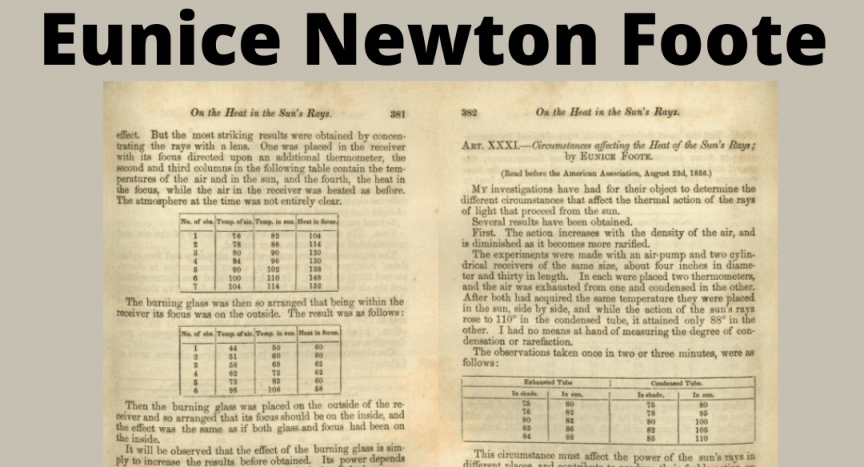Eunice Newton Foote – She was the first one to observe the effect of carbon dioxide in the atmosphere in 1856. We know this now as the Greenhouse Effect, the increase in which is causing our current global warming.
We are all now fully aware that human induced activities have and are releasing carbon dioxide into the atmosphere and this carbon has warmed our planet, resulting in a changing climate. What most of us don’t know is that while even the ancient Greeks knew that human activities can change climate, it was a woman scientist in the 19th century, who actually wrote a scientific paper theorizing that altering the proportion of carbon dioxide in the atmosphere would also alter its temperature. Her name was Eunice Newton Foote and her paper Circumstances affecting the heat of the sun’s rays was presented at the American Association for the Advancement of Science (AAAS) conference in 1856. But the paper was not delivered by her but by a man – Professor Joseph Henry of the Smithsonian Institution. The paper was published later in 1856, under her name in the American Journal of Science and Arts but was never included in the Proceedings (a published record of the papers presented at the annual meetings) of the AAAS Conference.
After conducting a series of experiments demonstrating the effects of the Sun’s rays on different gases in 1856, Eunice Foote wrote in her paper, “The highest effect of the sun’s rays I have found to be in carbonic acid gas”. Carbon dioxide (CO2) was known as carbonic acid gas at the time and Eunice theorized that the proportion of CO2 in the atmosphere changed its temperature. Effectively, she had discovered that the main components of the greenhouse effect – the ability of gases in the atmosphere to trap solar heat – first highlighted by French scientist Joseph Fourier in the 1820s, were CO2 gas and water vapour; concluding that more CO2 could increase atmospheric temperature by trapping more heat. She wrote, “An atmosphere of that gas would give to our earth a high temperature; and if, as some suppose, at one period of its history, the air had mixed with it a larger proportion than at present, an increased temperature from its own action, as well as from increased weight, must have necessarily resulted.”
Atmospheric carbon dioxide reached 419 parts per million (ppm) in May 2021. At the time Eunice wrote her paper, it was at 290ppm, so global climate change was not an issue. But her theory predicted that changing CO2 levels in the atmosphere could change global temperatures. We now know that she was right.
Eunice Newton Foote performed her experiments and wrote her conclusions three years before Irish physicist John Tyndall came to the same conclusion in 1859. Tyndall’s research was more sophisticated, with better lab equipment and it highlighted – for the first time – that gases both trapped and emitted infrared thermal radiation rather than sunlight. His work, published by the Royal Society is generally (and rightly) regarded as the foundation of climate science. While he gave credit to other male scientists for inspiring his research, he did not mention Eunice, either because he was unaware of her work or thought it irrelevant. Tyndall’s work was indeed seminal, but while Foote’s simple apparatus could not distinguish between visible and infrared radiation, she still deserved credit for her work.
However, she was a woman at a time when women were not provided with the same education as men. Those that did manage to overcome this, were excluded from many scientific societies and publications. Science was a male dominated field and while women could join some societies like the American Academy for the Advancement of Science (AAAS), there was an entrenched heirarchy that looked at men as “professionals” or fellows and women as “amateurs” or just “members”. Perhaps it was also that John Tyndall’s opinion of women scientists was prejudiced by sexism. His biography The Ascent of John Tyndall says that he “often exhibited surprise at women’s intellectual capabilities, and though he imagined that women could understand anything revealed by the savants, he did not believe they had the same powers of imagination and discovery.”
(Video Mary Wollstonecraft – Fantastic Women Series)
Eunice did not stop at just the one paper. Her second scientific publication On a new source of electrical excitation was published the following year. Women in the USA wrote sixteen papers in physics in the 19th century, out of which only two were published – both by Eunice Newton Foote.
She was a farmer’s daughter, born 1819 in Goshen, Connecticut, but grew up In Bloomfield, New York, USA, and was educated at the Troy Female Seminary in 1836–38, from ages 17-19, where she was taught scientific theory. Students of the seminary were allowed to attend a nearby science college and there Foote learned foundational chemistry and biology. There she was influenced by the textbooks of Almira Hart Lincoln Phelps, a female pioneer of women in science, a botany expert, and the third female member of the AAAS (American Academy for the Advancement of Science). This college, the Rensselaer Polytechnic Institute, provided a science curriculum and also housed the only two chemistry labs in the world for students. Here Eunice must have learned lab techniques and how to conduct scientific research that played such a role in her work.
According to Scientific American at that time, Eunice’s experiments and paper offered “abundant evidence of the ability of woman to investigate any subject with originality and precision.” However, Eunice was forgotten, and her work then seems to have disappeared from scientific history and knowledge. It was mere chance that it was re-discovered by retired petroleum geologist Raymond Sorenson, who found a description of her paper in the 1857 edition of Annual of Scientific Discovery and spread the word.
(More Fantastic Women: Ada Lovelace, Mary Anning and Cecilia Payne Gaposchkin)
Eunice Newton married Elisha Foote, a judge, statistician and inventor in 1841. In addition to being a scientist she was also a campaigner for women’s rights. She was a member of the editorial committee for the 1848 Seneca Falls Convention, the first convention on women’s rights. As a member, she and her husband were signatories of the convention’s Declaration of Sentiments, also known as the Declaration of Rights and Sentiments, a document signed by 68 women and 32 men, 100 out of around 300 of the convention’s attendees.
She died on September 30, 1888 (aged 69) in Lennox, Massachusetts and is interred at Green-Wood Cemetery, Brooklyn, NYC.
Eunice Newton Foote’s paper is an integral part of the understanding of human impact on Earth’s climate – a first step taken by a woman scientist to increase the climate science knowledge we have today.
There are no known images of her but here is a photo of her paper:

Eunice Newton Foote’s paper on CO2 and Global Warming. From https://archive.org/details/mobot31753002152491/page/381/mode/2up

Eunice Newton Foote’s paper on CO2 and Global Warming. From https://archive.org/details/mobot31753002152491/page/381/mode/2up






